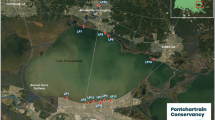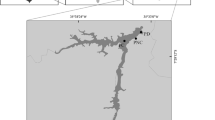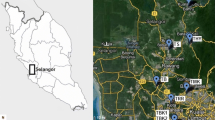Abstract
To date, most research on cyanobacterial blooms has focused on high-nutrient, not low-nutrient lakes. We investigated reports of the cyanobacterium Gloeotrichia echinulata in lakes with low concentrations of nitrogen and phosphorus across the northeastern United States by surveying selected oligotrophic and mesotrophic lakes during four summers. G. echinulata is a large (1–3 mm diameter) colonial cyanobacterium that may have substantial effects on low-nutrient lakes used for drinking water and recreation because it can produce the toxin microcystin-LR. We found G. echinulata in the water column of 27 out of 37 lakes we sampled in Maine, New Hampshire, New York, and Vermont. G. echinulata densities were typically low (<5 colonies L−1), but occasionally at surface scum-producing levels (up to 250 colonies L−1). G. echinulata colonies from the survey lakes exhibited detectable microcystin-LR concentrations ranging from 58 to 7,148 ng microcystin-LR g−1 dry weight colonies. If G. echinulata densities increase to bloom levels observed in eutrophic systems, our data suggest that the microcystin-LR concentrations attributable to G. echinulata may reach levels known to influence aquatic organisms and pose human health risks.




Similar content being viewed by others
References
ALSC, Adirondack Lake Survey Corporation. Ray Brook, New York. http://www.adirondacklakessurvey.org/Accessed 18 Aug 2011
Anderson DM, Glibert PM, Burkholder J (2002) Harmful algal blooms and eutrophication: nutrient sources, composition, and consequences. Estuar Coast 25:704–726
AWI, Adirondack Watershed Institute, Adirondack Lake Assessment Program. Saranac Lake, New York. http://www.protectadks.org/programs/lakeassessment-alap/. Accessed 18 Aug 2011
AWSD, Auburn Water and Sewerage Districts. Auburn, Maine. http://www.awsd.org/waterindex.html
Babica P, Blaha L, Marsalek B (2006) Exploring the natural role of microcystins- a review of effects on photoautotrophic organisms. J Phycol 42:9–20
Backer L (2002) Cyanobacterial harmful algal blooms (CyanoHABs): developing a public health response. Lake Reserv Manage 18:20–31
Barbiero RP (1993) A contribution to the life-history of the planktonic cyanophyte, Gloeotrichia echinulata. Arch Hydrobiol 127:87–100
Barbiero RP, Welch EB (1992) Contribution of benthic blue-green algal recruitment to lake populations and phosphorus translocation. Freshw Biol 27:249–260
Boyer GL (2008) Cyanobacterial toxins in New York and the lower Great Lakes ecosystems. In: Hudnell HK (ed) Cyanobacterial harmful algal blooms: state of the science and research needs. Springer, New York, pp 153–165
Bunting L, Leavitt PR, Gibson CE, McGee EJ, Hall VA (2007) Degradation of water quality in Lough Neagh, Northern Ireland, by diffuse nitrogen flux from a phosphorus-rich catchment. Limnol Oceanogr 52:354–369
Carey CC, Haney JF, Cottingham KL (2007) First report of microcystin-LR in the cyanobacterium Gloeotrichia echinulata. Env Toxicol 22:337–339
Carey CC, Weathers KC, Cottingham KL (2008) Gloeotrichia echinulata blooms in an oligotrophic lake: helpful insights from eutrophic lakes. J Plank Res 30:893–904
Carey CC, Weathers KC, Cottingham KL (2009) Increases in phosphorus at the sediment-water interface may accelerate the initiation of cyanobacterial blooms in an oligotrophic lake. Verh Int Verein Limnol 30:1185–1188
Carr NG, Whitton BA (eds) (1982) The biology of cyanobacteria. Botanical monographs, vol 19. University of California Press, Los Angeles
Chang TP (1979) Growth and acetylene reduction by Gloeotrichia echinulata (Smith) Richter in axenic culture. Brit Phycol J 14:207–210
Chorus I, Bartram J (1999) Toxic cyanobacteria in water: a guide to their public health consequences, monitoring, and management. E & FN Spon, London
Christoffersen K (1996) Ecological implications of cyanobacterial toxins in aquatic ecosystems. Phycologia 35:42–50
Cottingham KL, Carpenter SR, St Amand AL (1998) Responses of epilimnetic phytoplankton to experimental nutrient enrichment in three small seepage lakes. J Plank Res 20:1889–1914
Crumpton WG, Isenhart TM, Mitchell PD (1992) Nitrate and organic N analyses with second-derivative spectroscopy. Limnol Oceanogr 37:907–913
Davis RB, Bailey JH, Scott M, Hunt G, Norton SA (1978) Descriptive and comparative studies of Maine Lakes. Agriculture Experiment Station Technical Bulletin, vol 88. Life Sciences and Agriculture Experiment Station, University of Maine, Orono
DeMott WR, Zhang Q-X, Carmichael WW (1991) Effects of toxic cyanobacteria and purified toxins on the survival and feeding of a copepod and three species of Daphnia. Limnol Oceanogr 36:1346–1357
Downing JA, Watson SB, McCauley E (2001) Predicting cyanobacteria dominance in lakes. Can J Fish Aquat Sci 58:1905–1908
Downing TG, Sember CS, Gehringer MM, Leukes W (2005) Medium N:P ratios and specific growth rate comodulate microcystin and protein content in Microcystis aeruginosa PCC7806 and M. aeruginosa UV027. Microb Ecol 49:468–473
Eiler A, Olsson JA, Bertilsson S (2006) Diurnal variations in the auto- and heterotrophic activity of cyanobacterial phycospheres (Gloeotrichia echinulata) and the identity of attached bacteria. Freshw Biol 51:298–311
El Ghazali I, Saqrane S, Carvalho AP, Ouahid Y, Del Campo FF, Vasconcelos V, Oudra B (2010) Effects of the microcystin profile of a cyanobacterial bloom on growth and toxin accumulation in common carp Cyprinus carpio larvae. J Fish Biol 76:1415–1430
Eloff JN, van der Westhuizen AJ (1981) Toxicological studies on Microcystis. In: Carmichael WW (ed) The water environment—algal toxins and health. Plenum Press, New York, pp 343–364
Ernst B, Hoeger SJ, O’Brien E, Dietrich DR (2009) Abundance and toxicity of Planktothrix rubescens in the pre-alpine Lake Ammersee, Germany. Harmful Algae 8:329–342
Fey SB, Mayer ZA, Davis SC, Cottingham KL (2010) Zooplankton grazing of Gloeotrichia echinulata and associated life history consequences. J Plank Res 32:1337–1347
Forsell L (1998) Migration from the littoral zone as an inoculum for phytoplankton. Arch Hydrobiol Spec Iss Adv Limnol 51:21–27
Forsell L, Pettersson K (1995) On the seasonal migration of the cyanobacterium Gloeotrichia echinulata in Lake Erken, Sweden, and its influence on the pelagic population. Mar Freshw Res 46:287–293
FTP (2008) Fairlee Town Plan, Fairlee Planning Commission. Fairlee, Vermont, www.fairleevt.org/PDF/up/fairtwnpln120908.pdf. Accessed 19 Aug 2011
Fulton RS, Paerl HW (1987) Toxic and inhibitory effects of the blue-green alga Microcystis aeruginosa on herbivorous zooplankton. J Plank Res 9:837–855
Galvao HM, Reis MP, Valerio E, Domingues RB, Costa C, Lourenco D, Condinho S, Miguel R, Barbosa A, Gago C, Faria N, Paulino S, Pereira P (2008) Cyanobacterial blooms in natural waters in southern Portugal: a water management perspective. Aquat Microb Ecol 53:129–140
Hallegraeff GM (1993) A review of harmful algal blooms and their apparent global increase. Phycologia 32:79–99
Hernández JM, López-Rodas V, Costas E (2009) Microcystins from tap water could be a risk factor for liver and colorectal cancer: a risk intensified by global change. Med Hypotheses 72:539–540
Hochberg Y (1988) A sharper Bonferroni procedure for multiple test of significance. Biometrika 75:800–802
Hyenstrand P, Rydin E, Gunnerhed M, Linder J, Blomqvist P (2001) Response of the cyanobacterium Gloeotrichia echinulata to iron and boron additions—an experiment from Lake Erken. Freshw Biol 46:735–741
Istvánovics V, Pettersson K, Rodrigo MA, Pierson D, Padisak J, Colom W (1993) Gloeotrichia echinulata, a colonial cyanobacterium with a unique phosphorus uptake and life strategy. J Plank Res 15:531–552
Jacobsen BA (1994) Bloom formation of Gloeotrichia echinulata and Aphanizomenon flos-aquae in a shallow, eutrophic, Danish lake. Hydrobiologia 289:193–197
JBS (2008) Jay Board of Selectmen, Jay Selectmen Minutes, 22 December 2008. Jay, Maine. http://jay-maine.org/select-minutes08.html. Accessed 19 Aug 2011
Jochimsen E, Carmichael W, An J, Cardo D, Cookson S, Holmes C, Antunes M, de Melo D, Lyra T, Barreto V, Azevedo S, Jarvis W (1998) Liver failure and death after exposure to microcystins at a hemodialysis center in Brazil. N Engl J Med 338:873–878
Kalff J (2002) Limnology. Prentice Hall, Upper Saddle River
Karlsson I (2003) Benthic growth of Gloeotrichia echinulata cyanobacteria. Hydrobiologia 506:189–193
Karlsson-Elfgren I, Rydin E, Hyenstrand P, Pettersson K (2003) Recruitment and pelagic growth of Gloeotrichia echinulata (Cyanophyceae) in Lake Erken. J Phycol 39:1050–1056
Karlsson-Elfgren I, Rengefors K, Gustafsson S (2004) Factors regulating recruitment from the sediment to the water column in the bloom-forming cyanobacterium Gloeotrichia echinulata. Freshw Biol 49:265–273
Karlsson-Elfgren I, Hyenstrand P, Rydin E (2005) Pelagic growth and colony division of Gloeotrichia echinulata in Lake Erken. J Plank Res 27:145–151
KB, KnowledgeBase database. Senator George J. Mitchell Center for Environmental and Watershed Research, University of Maine, Orono, Maine. http://www.gulfofmaine.org/kb. Accessed 18 Aug 2011
Kearns KD, Hunter ME (2001) Toxin-producing Anabaena flos aquae induces settling of Chlamydomonas reinhardtii, a competing motile algae. Microb Ecol 2:291–297
Kotak BG, Zurawell RW, Prepas EE, Holmes CFB (1996) Microcystin-LR concentration in aquatic food web compartments from lakes of varying trophic status. Can J Fish Aquat Sci 53:1974–1985
Kotak BG, Lam AKY, Prepas EE, Hrudey SE (2000) Role of chemical and physical variables in regulating microcystin-LR concentration in phytoplankton of eutrophic lakes. Can J Fish Aquat Sci 57:1584–1593
LCA, Lake Colby Association. Harrietstown, New York. www.lakecolby.org. Accessed 19 Aug 2011
LCBP, Lake Champlain Basin Program. Grande Isle, Vermont. www.lcbp.org/drinkwater.htm. Accessed 19 Aug 2011
Lee SJ, Jang MH, Kim HS, Yoon BD, Oh HM (2000) Variation of microcystin content of Microcystis aeruginosa relative to medium N:P ratio and growth stage. J Appl Microbiol 89:323–329
Lepisto L, Rapala J, Lyra C, Berg KA, Erkomaa K, Issakainen J (2005) Occurrence and toxicity of cyanobacterial blooms dominated by Anabaena lemmermannii P. Richter and Aphanizomenon spp. in boreal lakes in 2003. Arch Hydrobiol Supp 159:315–328
LSPA, Lake Sunapee Protective Association. Sunapee, New Hampshire. www.lakesunapee.org
Makarewicz JC, Boyer GL, Lewis TW, Guenther W, Atkinson J, Arnold M (2009) Spatial and temporal distribution of the cyanotoxin microcystin-LR in the Lake Ontario ecosystem: coastal embayments, rivers, nearshore and offshore, and upland lakes. J Great Lakes Res 35:83–89
Malbrouck C, Kestemont P (2006) Effects of microcystins on fish. Env Toxicol Chem 25:72–86
ME-DEP, Maine Department of Environmental Protection, Lake Assessment Program. Augusta, Maine. http://www.maine.gov/dep/water/lakes/index.html
ME-DWP, Maine Drinking Water Program, Maine Department of Health and Human Services, Division of Environmental Health. Augusta, Maine. www.maine.gov/dhhs/eng/water/sources.htm. Accessed 19 Aug 2011
ME-IWQAR (2006) Maine Integrated Water Quality Monitoring and Assessment Report. Maine Department of Environmental Protection. Augusta, Maine. http://www.maine.gov/dep/water/monitoring/305b/2006/2006_Final_305b_Report.pdf
ME-IWQAR (2008) Maine Integrated Water Quality Monitoring and Assessment Report. Maine Department of Environmental Protection. Augusta, Maine. http://www.maine.gov/dep/water/monitoring/305b/2008/report.pdf
ME-IWQAR (2010) Maine Integrated Water Quality Monitoring and Assessment Report. Maine Department of Environmental Protection. Augusta, Maine. http://www.maine.gov/dep/water/monitoring/305b/2010/report.pdf
Miura GA, Robinson NA, Lawrence WB, Pace JG (1991) Hepatotoxicity of microcystin-LR in fed and fasted rats. Toxicon 29:337–346
NH-DES-LWQR (2009) New Hampshire Department of Environmental Services, Lake Water Quality Reports. Concord, New Hampshire. http://des.nh.gov/organization/divisions/water/wmb/lakes/trophic_summary.htm. Accessed 18 Aug 2011
NH-DES-VLAP, New Hampshire Department of Environmental Services, Volunteer Lake Assessment Program. Concord, New Hampshire. http://des.nh.gov/organization/divisions/water/wmb/vlap/index.htm
NH-DWSPP, New Hampshire Drinking Water Source Protection Program, New Hampshire Department of Environmental Services. Concord, New Hampshire. http://des.nh.gov/organization/divisions/water/dwgb/dwspp/reports/part1. Accessed 18 Aug 2011
Nõges T, Tonno I, Laugaste R, Loigu E, Skakalski B (2004) The impact of changes in nutrient loading on cyanobacterial dominance in Lake Peipsi (Estonia/Russia). Arch Hydrobiol 160:261–279
Nürnberg GK (1996) Trophic state of clear and colored, soft- and hardwater lakes with special consideration of nutrients, anoxia, phytoplankton and fish. Lake Reserv Manage 12:432–447
Padisák J, Scheffler W, Kasprzak P, Koschel R, Krienitz L (2003) Interannual variability in the phytoplankton composition of Lake Stechlin (1994–2000). Adv Limnol 58:101–133
Paerl HW (1988) Nuisance phytoplankton blooms in coastal, estuarine, and inland waters. Limnol Oceanogr 33:823–847
Paerl HW, Huisman J (2008) Blooms like it hot. Science 320(5872):57–58
Paerl HW, Huisman J (2009) Climate change: a catalyst for global expansion of harmful cyanobacterial blooms. Env Microbiol Rep 1:27–37
Paerl HW, Fulton RS, Moisander PH, Dyble J (2001) Harmful freshwater algal blooms, with an emphasis on cyanobacteria. Sci World 1:76–113
Pettersson K, Herlitz E, Istvánovics V (1993) The role of Gloeotrichia echinulata in the transfer of phosphorus from sediments to water in Lake Erken. Hydrobiologia 253:123–129
Pflugmacher S (2002) Possible allelopathic effects of cyanotoxins, with reference to microcystin-LR, in aquatic ecosystems. Env Toxicol 17:407–413
Pierson DC, Pettersson K, Istvánovics V (1992) Temporal changes in biomass specific photosynthesis during the summer: regulation by environmental factors and the importance of phytoplankton succession. Hydrobiologia 243:119–135
Pietsch C, Wiegand C, Amé MV, Nicklisch A, Wunderlin D, Pflugmacher S (2001) The effects of a cyanobacterial crude extract on different aquatic organisms: evidence for cyanobacterial toxin modulating factors. Environ Toxicol 16:535–542
Pitois SG, Jackson MH, Wood BJB (1997) Summer bloom of Gloeotrichia echinulata and Aphanizomenon flos-aquae and phosphorus levels in Antermony Loch, central Scotland. Int J Environ Health Res 7:131–140
Reynolds CS (2006) Ecology of phytoplankton. Cambridge University Press, New York
Roelofs TD, Oglesby RT (1970) Ecological observations on planktonic cyanophyte Gleotrichia echinulata. Limnol Oceanogr 15:224–229
Rohrlack T, Dittman E, Borner T, Christoffersen K (2001) Effects of cell-bound microcystins on survival and feeding of Daphnia spp. Appl Environ Microbiol 67:3523–3529
Rohrlack T, Christoffersen K, Dittman E, Nogueira I, Vasconcelos V, Borner T (2005) Ingestion of microcystins by Daphnia: intestinal uptake and toxic effects. Limnol Oceanogr 50:440–448
Romanowska-Duda Z, Tarczynska M (2002) Influence of microcystin-LR and hepatotoxic cyanobacterial extract on the water plant Spirodela oligorrhiza. Env Toxicol 17:434–440
Sasner JJ, Haney JF, Ikawa M, Schloss JA (2001) Early signs and determinants of biotoxins (microcystins) in lakes. University of New Hampshire, Center for Freshwater Biology, Durham
Serediak N, Huynh M-L (2011) Algae identification Lab Guide. Agriculture and Agri-Food Canada, Agri-Environment Services. Ottawa
Stewart WD, Fitzgerald GP, Burris RH (1967) In situ studies on N2 fixation using the acetylene reduction technique. Proc Natl Acad Sci 58:2071–2078
Tonk L, Visser PM, Christiansen G, Dittmann E, Snelder E, Wiedner C, Mur LR, Huisman J (2005) The microcystin composition of the cyanobacterium Planktothrix agardhii changes toward a more toxic variant with increasing light intensity. Appl Environ Microbiol 71:5177–5181
Tymowski RG, Duthie HC (2000) Life strategy and phosphorus relations of the cyanobacterium Gloeotrichia echinulata in an oligotrophic Precambrian Shield lake. Arch Hydrobiol 148:321–332
USLA (2010) Upper Saranac Lake Association. Citizens Statewide Lake Assessment Report. https://secure.uppersaranac.com/_uploads/File/2010USL_CSLAPS.pdf. Accessed 18 Aug 2011
Utkilen H, Gjolme N (1992) Toxin production by Microcystis aeruginosa as a function of light in continuous cultures and its ecological significance. Appl Environ Microbiol 58(4):1321–1325
van der Westhuizen AJ, Eloff JN (1985) Effect of temperature and light on the toxicity and growth of the blue-green alga Microcystis aeruginosa (UV-006). Planta 163:55–59
Van Dolah FM (2000) Marine algal toxins: origins, health effects, and their increased occurrence. Environ Health Perspect 108:133–141
Van Veldhoven PP, Mannaerts GP (1987) Inorganic and organic phosphate measurements in the nanomolar range. Anal Biochem 161:45–48
Vareli K, Briasoulis E, Pilidis G, Sainis I (2009) Molecular confirmation of Planktothrix rubescens as the cause of intense, microcystin-synthesizing cyanobacterial bloom in Lake Ziros, Greece. Harmful Algae 8:447–453
VT-DEC-LC, Vermont Department of Environmental Conservation, Lake Champlain Long-term Water Quality and Biological Monitoring Project. Waterbury, Vermont. http://www.vtwaterquality.org/lakes/htm/lp_longterm.htm. Accessed 18 Aug 2011
VT-DEC-VLMP, Vermont Department of Environmental Conservation, Vermont Lay Monitoring Program, Waterbury, Vermont. http://www.vtwaterquality.org/lakes/htm/lp_volunteer.htm. Accessed 18 Aug 2011
Wetzel RG (2001) Limnology: lake and river ecosystems, 3rd edn. Academic Press, New York
WHO (1998) World Health Organization Guidelines for Drinking Water Quality, Addendum to vol 2, 2nd edn. Health Criteria and Other Supporting Information. World Health Organization, Geneva
Wiedner C, Visser PM, Fastner J, Metcalf JS, Codd GA, Mur LR (2003) Effects of light on the microcystin content of Microcystis strain PCC 7806. Appl Environ Microbiol 69:1475–1481
Wiegand C, Pflugmacher S (2005) Ecotoxicological effects of selected cyanobacterial secondary metabolites a short review. Toxicol Appl Pharmacol 203:201–218
Winter JG, DeSellas AM, Fletcher R, Heintsch L, Morley A, Nakamoto L, Utsumi K (2011) Algal blooms in Ontario, Canada: increases in reports since 1994. Lake Reserv Manage 27:107–114
Wynne TT, Stumpf RP, Tomlinson MC, Schwab DJ, Watabayashi GY, Christensen JD (2011) Estimating cyanobacterial bloom transport by coupling remotely sensed imagery and a hydrodynamic model. Ecol App 21:2709–2721
Acknowledgments
This work was supported by a National Science Foundation (NSF) Graduate Research Fellowship to C.C.C., NSF Doctoral Dissertation Improvement Grant DEB-1010862 to C.C.C. and Nelson G. Hairston, Jr.; NSF DEB-0749022 to K.L.C., K.C.W., and H.A.E.; NSF EF-0842267 to K.L.C.; NSF EF-0842112 to H.A.E.; NSF EF-0842125 to K.C.W.; and grants to C.C.C. from the Cornell Biogeochemistry and Biocomplexity Program, Andrew W. Mellon Foundation, Kieckhefer Adirondack Fellowship Program, Cornell Sigma Xi Chapter, Sigma Xi Grants-In-Aid of Research, and NSF Biogeochemistry and Biocomplexity IGERT. Additional support for sampling and analyses in Maine came from Bates College and the Bates College Imaging and Computing Center, which was supported by the Howard Hughes Medical Institute and NIH Grant Number P20 RR-016463 from the INBRE Program of the National Center for Research Resources. The contents of this paper are solely the responsibility of the authors and do not necessarily represent the official views of NIH. We thank G. and J. Montgomery, M. and T. Eliassen, R. Wood, and the Lake Sunapee Protective Association for logistical help and access to field sites. N. Ruppertsberger, S. Davis, A. Hagen-Dillon, A. Fiorillo, and L. Griesinger provided invaluable field and laboratory assistance. The N.G. Hairston, Jr. and A.S. Flecker laboratory groups provided constructive comments on this manuscript, and A. Lindsey prepared the GIS map.
Author information
Authors and Affiliations
Corresponding author
Additional information
Handling Editor: Bas W. Ibelings.
Rights and permissions
About this article
Cite this article
Carey, C.C., Ewing, H.A., Cottingham, K.L. et al. Occurrence and toxicity of the cyanobacterium Gloeotrichia echinulata in low-nutrient lakes in the northeastern United States. Aquat Ecol 46, 395–409 (2012). https://doi.org/10.1007/s10452-012-9409-9
Received:
Accepted:
Published:
Issue Date:
DOI: https://doi.org/10.1007/s10452-012-9409-9




